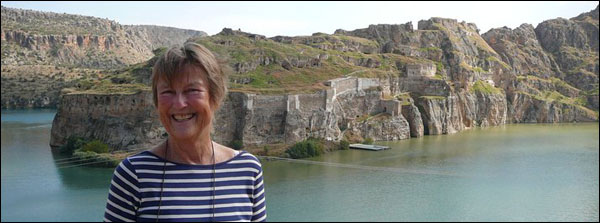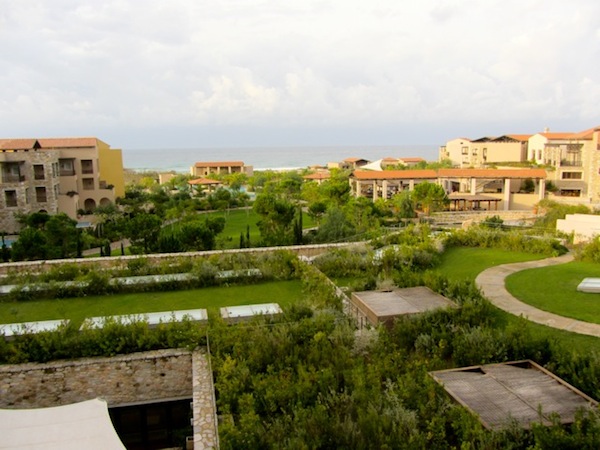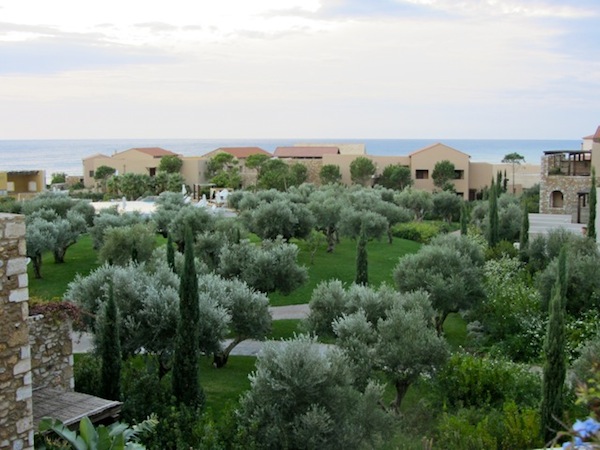Sniffing at The Hem of Luxury: The Costa Navarino at Pylos

Eating Well Is The Best Revenge
By Diana Farr Louis
“When at last my number came up, my magic card-key opened the door with a presto gismo, and I entered a suite almost as large as our flat in Kifissia—with two loos, two showers, a glass-top table with four seats, a lovely sofa and two armchairs, two TVs and a bed big enough for four.”—Diana Farr Louis
 ATHENS Greece—(Weekly Hubris)—12/2/2013—I’ve been down on the farm too long. The last time I stayed at a world-class fancy resort was back in 1997, when kind friends gave me a bungalow at the Elounda Mare on Crete as a base for my cookbook research. It even had its own private pool and the price listed behind the door was the equivalent of $1,000 a night.
ATHENS Greece—(Weekly Hubris)—12/2/2013—I’ve been down on the farm too long. The last time I stayed at a world-class fancy resort was back in 1997, when kind friends gave me a bungalow at the Elounda Mare on Crete as a base for my cookbook research. It even had its own private pool and the price listed behind the door was the equivalent of $1,000 a night.
I gasped, lay down on the king-sized bed and called Joy of the People, M.D. (my spouse) back in Athens. Such a lovely private playground: it seemed a shame to be luxuriating in it all alone. But I didn’t have much time to indulge in sybaritic pastimes as my benefactors, the Kokkotos family, also arranged for their kitchens to be opened to me during off-hours for demonstrations and for any employee related to a good cook to whisk me off to their home.
In the end, I managed a quick dip in my plunge pool and a few blissful nights slumbering in Morpheus’s arms all by myself. Paying strict attention and writing down recipes by hand can be tiring, and better done without the distractions posed by a charismatic doctor. My informants would have been begging for prescriptions for their health, rather than giving me, an American female, recipes. (In Greek, the same word is used for both: syntages.)
This time, my brief was simpler. No research; no hidden agenda. All I had to do was a minimal amount of shepherding about a group of 50 or so gardeners from Europe and the US to the southwest corner of the Peloponnese. Our destination: Pylos and one of Greece’s newest additions to the international holiday market, the Costa Navarino (www.costanavarino.com), a complex with two golf courses, two hotels, villas, pools, and the proverbial endless stretch of beach.

In the short time since it opened in June 2010, the resort has won all sorts of international awards that, rather exceptionally for Greece, put it among “the best of the world” in many different categories, including planting, and we were going to see what they’d done.
Getting there should have been half the fun. But when we piled into our bus in Kifissia (Athens) at 9 a.m., it was already drizzling. By the time we got to Nemea—where Hercules slew the dreaded Lion and where Dionysus turned the well water into wine—the rain was falling in sheets. But we had scheduled a tour of the Semele winery, not the ancient site, so we could drown our sorrows in the crisp whites and fruity reds of the area. A full and excellent lunch followed the tastings so, by the time we got back on the bus, the rain was but a minor annoyance, something to lull us to sleep.
However, narrow twisty roads in Greek villages were designed for donkeys and tractors, not ginormous tourist buses and, while getting up to Semele had been slow, getting back down to the highway took well over an hour. This was because we were not moving. At all. Our descent coincided with a funeral, so our ribbon of a road was clogged with badly parked cars and pick-ups. No way could we inch through. And no way could our driver, Yannis, honk his horn to get their owners to move: it would have been a serious breach of etiquette. One must respect the dead. And the mourners.
Being either tipsy or comatose, my fellow travelers did not seem to mind. Only Katie, our trip coordinator, worried and kept calling the Costa Navarino to push back our program for the evening.
When we finally set off again, after 4 p.m., darkness was already hovering and the rain gathering force. By the time we approached Kalamata, on a spiffy new highway, those in the front seats could see rocks bouncing down the embankments onto the asphalt. Our heroic driver steered around them and got us to our hotel by 7:30, too late for anything but dinner.
The next morning, we learned how lucky we had been. Another tour bus had been stranded on the highway for three hours that night, unable to move.
I checked in with my bus-mates and then set off to find room No. 6719. Reception was on the fifth floor, though it looked level with the ground, so I was only one floor up. And then what? I walked down an endless, dimly lit corridor, over sodden wooden planks that were sometimes open to the elements, sometimes roofed, getting showered at every open patch, while peering at obscure room numbers. Not a foul-weather-friendly design.
When at last my number came up, my magic card-key opened the door with a presto gismo, and I entered a suite almost as large as our flat in Kifissia—with two loos, two showers, a glass-top table with four seats, a lovely sofa and two armchairs, two TVs and a bed big enough for four. Partouze, anyone?
The first TV was on and the screen had a message: “Welcome Diana Louis.” What followed should have been a guide to the myriad facilities, restaurants, shops, and activities offered by the hotel but, being a bit of a Luddite, I had trouble getting the zapper to go where I wanted it to, or perhaps the program was too elaborate?
In any case, I switched it off and stepped out onto my spacious balcony. Lights sparkled everywhere, while small pools six floors below shimmered like turquoise bagatelles. Nice, I thought. Until I entered my bedroom, and there, a couple of feet from the playground of a bed, sat a gleaming white bath tub. Would I have to sleep with it?

Fortunately, before I turned in later, I found a button among the many on the light control panel activating a screen which rolled down from the ceiling and separated the cold porcelain from the cozy duvet. But I do think the room should have come with an instruction manual. The shower was also deceptive, with a secret head in the ceiling that drenched several of us, while getting the right temperature was a feat I never mastered.
Too old for such hi-tech luxuries?
The restaurant was futuristic, too, and agony for a choice-challenged Libra.
Buffet-style, it had at least seven long counters featuring different dishes: appetizers and salads, baked or stewed meats and fish, a grill station where a chef was cooking succulent shrimp (no decision-making problem there), breads, cheeses, desserts, toppings . . . OK, I could have a little of everything, well, almost everything, so decisions were unnecessary.
Breakfast was the same, but easier for me since I never have room for much more than a croissant and a grapefruit half.
Yet I was comforted by the fact that Costa Navarino sources all its raw ingredients—not just the famous Kalamata olives and oil—from the region; that they employ a thousand people to serve the possible 1,500 guests and have created jobs for another two thousand; that local families which had emigrated to Germany, Australia, and elsewhere were returning to fill new posts at home in Greece.
But what about those gardens? It was still too wet for a tour, so we watched a glorious slideshow of the Yialova Lagoon next door narrated by biologist/brilliant photographer Andrea Bonetti (www.andreabonetti.com).
By afternoon, the sun graced us long enough for an analog walk around the lagoon, and then, finally, we were shown the gardens. The hotel complex covers 1,000 ha or 2,500 acres, so we didn’t see it all, but the management are doing their best to be eco-friendly, using recycled water on their golf courses, adding 5,000 sq m of green roofs to the thousands of hardy Mediterranean plants surrounding their buildings, and saving 6,000 venerable olive and citrus trees. (They dug them up before construction started, replanted them in temporary locations, and then transplanted them on the grounds. Only four trees were lost, an amazing statistic.)
But, of course, how could they resist the temptation to install lawns? They are so pleasing to the eye; such a symbol of luxury. Never mind that lawns and olive trees don’t really go together, either visually or in terms of thirst. We can only hope that those Methuselahs will not succumb to overwatering.

At the moment, there’s no point in worrying. The Peloponnese and, indeed, all of Greece is being watered from on high to an extent never seen by old-timers. We’re not The Philippines, yet, but there have been floods and deaths here due to them.
So, congratulations to Costa Navarino for making a huge resort that is luxurious but not vulgar, for having a conscience, and for bringing new life to a sleepy corner of Greece. And congratulations to our trouper-gardeners, whose spirits never flagged and who were such good company on our very wet journey to and from Pylos.
Sadly, our return, which should have included a walk round the recently excavated, partially restored site of elegant Ancient Messini, took place in the same monsoon conditions. But our lunch at the Ithome Taverna next door kept us smiling all the way back.

RECIPE
I wish I could reproduce some of the wonderful meals we had. I wish I could remember what we ate. My amnesia comes from palate-overload, so what remains with me is the totally divine roast pork with crackling at the Ithome Taverna at Ancient Messini. But our first lunch at the Semele winery did have some excellent stuffed cabbage rolls, so that’s what I’ll give you here. Fittingly, the recipe comes from a wonderful cook at Elounda Mare’s sister hotel on Crete, learned those many long years ago when I visited.
Ypapandi’s Stuffed Cabbage Leaves
Ee Lachanodolmádes tis Ypapándis
One afternoon in the kitchen of the Porto Elounda Hotel, while Ypapandi Velivasaki was showing me how she stuffs vine leaves and zucchini blossoms, she also rattled off her recipe for stuffed cabbage. The unusual addition of yogurt and feta here add an interesting piquancy to this soothing dish.
If you are one of those who doesn’t trust a skinny cook, you would feel comfortable with Ypapandi. In her mid-40s, she’s very round, very animated, and wears the happy expression of someone who loves her work. I saw that look on the faces of several chefs on Crete. Though she’s been working since the age of eight, Ypapandi has always enjoyed cooking and, early on, discovered she could make things taste much better than her mother could.
Ingredients
1 large green cabbage
½ kg (1 lb) ground beef or pork
1 medium onion, finely chopped
120 ml (½ cup) olive oil
200 grams (1 cup) long grain rice
1 egg, lightly beaten
2 tablespoons strained yogurt
2 tablespoons grated feta
2 tablespoons chopped dill
juice of 1 lemon
For the egg-lemon sauce
1 tablespoon flour
60 ml (¼ cup) fresh lemon juice or more
2 small eggs, beaten
Parboil the cabbage in plenty of water for about 10 minutes. Drain and when cool enough to handle, carefully separate the leaves from the cabbage head. Lay on paper towels or dishtowels to dry and slice off thick ribs near the stem end. The leaves should be soft and floppy enough to roll. If some of the inner ones have remained crisp, parboil them again for 2 minutes.
Heat 3 tablespoons of olive oil in a large heavy frying pan and gently sauté the onion until soft and translucent. Add the chopped meat and brown until all traces of pink vanish. Let cool and then mix in the other ingredients.
Oil the bottom of a large saucepan and then line it with torn or unstuffable cabbage leaves. To stuff the leaves, put a tablespoon of filling in the middle of each leaf about 4 cm (1 ½ inches) from the wide end, fold the bottom over the filling and roll towards the top, folding the sides towards the center as you go. If the leaves are very large, cut them in half with scissors. Lay the stuffed leaves seam-side down in the pan. Repeat the procedure until you have used up all the stuffing. Pour in the remaining olive oil, lemon juice and some water until the liquid is about half way up the dolmádes, and strew any unused leaves over them. Place an old plate on top of the cabbage rolls to keep them from unravelling, bring to the boil, cover and simmer for about 1 hour.
Remove the cabbage rolls to a platter, reserving their liquid, and set in the oven to keep warm while you make the egg-lemon sauce.
Beat the eggs with the lemon juice in a small saucepan. Slowly beat in several tablespoons of liquid from the cabbage rolls and then add to it all the remaining liquid. Heat the sauce very gently, stirring all the while, until it thickens to the consistency of thin custard. Serve the cabbage rolls and sauce separately. Serves 4-6.
(This recipe comes from my book, Feasting and Fasting in Crete, http://us.macmillan.com/prosperoskitchen/DianaFarrLouis)

5 Comments
di Drymoussis
Wish I’d been with you… !
di
x
Will
This is a delightful description; the resort sounds wonderful – if perilous to reach! And I cannot wait to try that brilliant addition of yogurt and feta to the stuffed leaves. I wonder if those two will hold up to being stuffed into more robustly flavored collard leaves? One way to find out……………………….
Vivien Psaropoulou
Thank you, Diana.
Your article brings back memories of a wonderful time spent at the Costa Navarino and on our trip generally.
\Penny Smith
All your articles were a joy to read, never stop.
diana
xxx and thanks to Penny & Vivien.